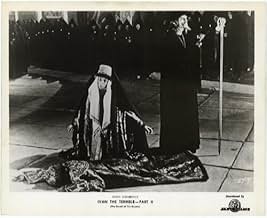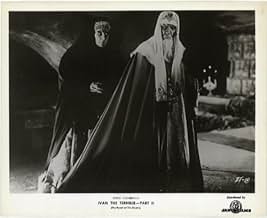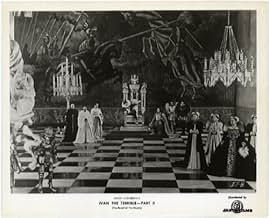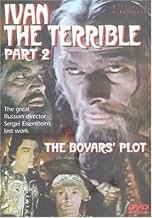IMDb रेटिंग
7.7/10
8.5 हज़ार
आपकी रेटिंग
अपनी भाषा में प्लॉट जोड़ेंAs Ivan the Terrible attempts to consolidate his power by establishing a personal army, his political rivals, the Russian boyars, plot to assassinate their Tsar.As Ivan the Terrible attempts to consolidate his power by establishing a personal army, his political rivals, the Russian boyars, plot to assassinate their Tsar.As Ivan the Terrible attempts to consolidate his power by establishing a personal army, his political rivals, the Russian boyars, plot to assassinate their Tsar.
- निर्देशक
- लेखक
- स्टार
- पुरस्कार
- कुल 1 नामांकन
Vsevolod Pudovkin
- Nikolay the Fanatic
- (as V.I. Pudovkin)
Ada Voytsik
- Elena Glinskaya, Ivan's Mother
- (as Ada Vojtsik)
Aleksandr Rumnev
- The Stranger
- (बिना क्रेडिट के)
Semyon Timoshenko
- Kaspar von Oldenbock, Livonian ambassador
- (बिना क्रेडिट के)
फ़ीचर्ड समीक्षाएं
10zetes
There is not a single criticism I could make for either Ivan the Terrible Film. They are perfect films, original, effective, and affecting. Perhaps the two best films ever made. If not, they're to be included on my list of totally invaluable films, with not a doubt in my mind.
II begins exactly where I ends. Ivan has consolidated his power in Moscow, at least with the people (though not with the nobles, or "boyars"). In fact, what power he has inspires jealousy and fear in the boyars.
Ivan I builds Ivan up as a noble character. We despise the boyars for their flagrant wealth and greed, and we like Ivan for supporting the people. His closest comrades seem like Homeric heroes.
Ivan II develops Ivan's character even further. He may have power, but he still feels alone on the throne. His two greatest friends have left him, one gone to religion and one to the enemy. His immediate underlings, perceived as heroes in Ivan I, have grown paranoid and powerful. They convince Ivan to execute left and right. The only route for the boyars is to conspire Ivan's death.
Ivan II leads up to one of the single greatest climax I can think of. To heighten the effect, for the first time, Eisenstein opted to shoot in color. And as masterful as he was with black and white, he is also with color. The juxtaposition of color with black and white is absolutely amazing.
The only problem with the film is no one's fault. Part II ends, open for the third installment. Alas, Sergei Eisenstein would die before its completion. We're lucky enough to have Ivan the Terrible Part II, for Stalin demanded that it not be released theatrically, believing Ivan to be a portrait of himself. Eisenstein, in fact, never had the chance to see it released theatrically, was never to hear the lavish praise from critics the world round. Here I praise it, hoping that in the next world possibly Eisenstein can know what masterworks he made.
II begins exactly where I ends. Ivan has consolidated his power in Moscow, at least with the people (though not with the nobles, or "boyars"). In fact, what power he has inspires jealousy and fear in the boyars.
Ivan I builds Ivan up as a noble character. We despise the boyars for their flagrant wealth and greed, and we like Ivan for supporting the people. His closest comrades seem like Homeric heroes.
Ivan II develops Ivan's character even further. He may have power, but he still feels alone on the throne. His two greatest friends have left him, one gone to religion and one to the enemy. His immediate underlings, perceived as heroes in Ivan I, have grown paranoid and powerful. They convince Ivan to execute left and right. The only route for the boyars is to conspire Ivan's death.
Ivan II leads up to one of the single greatest climax I can think of. To heighten the effect, for the first time, Eisenstein opted to shoot in color. And as masterful as he was with black and white, he is also with color. The juxtaposition of color with black and white is absolutely amazing.
The only problem with the film is no one's fault. Part II ends, open for the third installment. Alas, Sergei Eisenstein would die before its completion. We're lucky enough to have Ivan the Terrible Part II, for Stalin demanded that it not be released theatrically, believing Ivan to be a portrait of himself. Eisenstein, in fact, never had the chance to see it released theatrically, was never to hear the lavish praise from critics the world round. Here I praise it, hoping that in the next world possibly Eisenstein can know what masterworks he made.
Ivan the Terrible marks the final stages of the cinema's greatest creative genius: SERGI EISENSTEIN. It is the work of a director, a supreme artist who never ceased in probing new boundires, striking out uncharted paths, and searching the outer limits of his art. In the work, Eisenstein has gone eons beyond his earlier methods of film creation and for the first time approaches a true synthesis of dance, music, poetry, painting, photography, architecture, and all other forms of aesthetic communication.
The trials and tribulations surrounding the production and distribution of Ivan have become legendary in there own right. The film drew sharp criticism from Stalin and Eisenstein was forced to publicly announce his ''formalist errors.'' Subsequently, the film was banned in Russia until 1958 and Eisenstein was ostracized for what many saw as a film full of ''excess.'' It took many years before the world would come to realize it is nothing short of his greatest masterpiece.
A true cinematic realization of the ever elusive ''total work of art.'' A concept that originated with the Ancient Greeks and was further formulated by Richard Wagner in his epic masterwork, ''THE RING CYCLE.'' The Gestanmueack or ''intragel work of art'' as Wagner called it was in essence the synthesizing of every artistic medium into a single polyphonic experience. In the 20th century Eisenstein saw Wagner's music dramas as predecessors of cinema; a cinema that synthesized elements of all of mankind's arts into a single majestic, visceral and emotional experience which could transform and transfix the spectator. Together with the world renowned composer, master Sergei Prokofiev, and his lifelong cinematographer Eduard Tisse, Eisenstein labored for years researching and planning out every camera angle, lighting scheme, musical note, costume, color palette, gesture, and perspective; until every scene in Ivan becomes an intricate and complex world of its own. A world where actors twist and bend their forms to the limits of the plastic frame, shadows conceal and light reveals, the musical notes flow with the rhythm and tempo of the visual image and in the famous banquet scene, colors are used by Eisenstein to delve into the psychological states of the character's mind and state of being. It becomes a universe composed so precisely and diligently that every frame is infused with hidden metaphorical and symbolic meanings, and serves to create the epitome of cinematic achievement.
Tragically, like Schubert's great ''Unfinished Symphony'' or the Venus di Milo, Eisenstein passed away before completing the final part of his epic masterwork. What remains of Ivan the Terrible will live forever as a testament not only to the genius of Sergei Eisenstein but also to his unparalleled contribution to the world culture of the 20th century.
The trials and tribulations surrounding the production and distribution of Ivan have become legendary in there own right. The film drew sharp criticism from Stalin and Eisenstein was forced to publicly announce his ''formalist errors.'' Subsequently, the film was banned in Russia until 1958 and Eisenstein was ostracized for what many saw as a film full of ''excess.'' It took many years before the world would come to realize it is nothing short of his greatest masterpiece.
A true cinematic realization of the ever elusive ''total work of art.'' A concept that originated with the Ancient Greeks and was further formulated by Richard Wagner in his epic masterwork, ''THE RING CYCLE.'' The Gestanmueack or ''intragel work of art'' as Wagner called it was in essence the synthesizing of every artistic medium into a single polyphonic experience. In the 20th century Eisenstein saw Wagner's music dramas as predecessors of cinema; a cinema that synthesized elements of all of mankind's arts into a single majestic, visceral and emotional experience which could transform and transfix the spectator. Together with the world renowned composer, master Sergei Prokofiev, and his lifelong cinematographer Eduard Tisse, Eisenstein labored for years researching and planning out every camera angle, lighting scheme, musical note, costume, color palette, gesture, and perspective; until every scene in Ivan becomes an intricate and complex world of its own. A world where actors twist and bend their forms to the limits of the plastic frame, shadows conceal and light reveals, the musical notes flow with the rhythm and tempo of the visual image and in the famous banquet scene, colors are used by Eisenstein to delve into the psychological states of the character's mind and state of being. It becomes a universe composed so precisely and diligently that every frame is infused with hidden metaphorical and symbolic meanings, and serves to create the epitome of cinematic achievement.
Tragically, like Schubert's great ''Unfinished Symphony'' or the Venus di Milo, Eisenstein passed away before completing the final part of his epic masterwork. What remains of Ivan the Terrible will live forever as a testament not only to the genius of Sergei Eisenstein but also to his unparalleled contribution to the world culture of the 20th century.
Ivan the Terrible Part II, the culmination of Eisenstein's career, is easily one of the most brilliant films of all time.
Nothing - repeat absolutely nothing - in this film is sub-par. The acting, especially the inhuman physical contortions of Nikolai Cherkasov as the Tsar himself, is uniformly excellent. As is to be expected from Eisenstein, the direction is perfect. Eisenstein's compositions create painterly tableaux that can be watched endlessly on pause (especially now that Criterion has issued both Ivans on DVD), allowing the audience to take in the full breadth of this man's genius. Additionally, unlike, for example, Alexander Nevsky or Strike, Ivan the Terrible Part II (and part I) benefits from a smoother pace and better editing, putting Eisenstein's theory of montage to its best use since Potemkin.
For me, however, what two key components of this film set it apart from its prequel and Eisenstein's earlier Potemkin and October.
Those components, as you can imagine, are its more pronounce political allegory and its color sequence towards the end.
Certainly October and Potemkin were highly politicized affairs, both celebrating the Communist victory in Russia. In Ivan the Terrible Part II (and to a lesser extent Part I), the audience bears witness to a moment of challenge wherein Eisenstein becomes critical of the course his country and its post-Lenin leaders have taken. As such, Ivan the Terrible becomes one of the bravest moments in film history and, for that alone, should be commended.
Brilliant as a political critique, the film also represents a dazzling demonstration of how color could be used in cinema. The colorized dance at the end of the film rivals and prefigures the technicolor explosion in Douglas Sirk's 1950s melodramas; furthermore, it reveals that color can be used to achieve specific effects. It does not have to mimic reality; rather it can be used artistically to enhance the mood and atmosphere of the film.
Taken as a whole, the two-part Ivan the Terrible is a masterpiece of Russian Cinema and should be required viewing for anyone with the slightest bit of interest in film. My preference lies with the second part, but both are fantastic moments in film history.
Nothing - repeat absolutely nothing - in this film is sub-par. The acting, especially the inhuman physical contortions of Nikolai Cherkasov as the Tsar himself, is uniformly excellent. As is to be expected from Eisenstein, the direction is perfect. Eisenstein's compositions create painterly tableaux that can be watched endlessly on pause (especially now that Criterion has issued both Ivans on DVD), allowing the audience to take in the full breadth of this man's genius. Additionally, unlike, for example, Alexander Nevsky or Strike, Ivan the Terrible Part II (and part I) benefits from a smoother pace and better editing, putting Eisenstein's theory of montage to its best use since Potemkin.
For me, however, what two key components of this film set it apart from its prequel and Eisenstein's earlier Potemkin and October.
Those components, as you can imagine, are its more pronounce political allegory and its color sequence towards the end.
Certainly October and Potemkin were highly politicized affairs, both celebrating the Communist victory in Russia. In Ivan the Terrible Part II (and to a lesser extent Part I), the audience bears witness to a moment of challenge wherein Eisenstein becomes critical of the course his country and its post-Lenin leaders have taken. As such, Ivan the Terrible becomes one of the bravest moments in film history and, for that alone, should be commended.
Brilliant as a political critique, the film also represents a dazzling demonstration of how color could be used in cinema. The colorized dance at the end of the film rivals and prefigures the technicolor explosion in Douglas Sirk's 1950s melodramas; furthermore, it reveals that color can be used to achieve specific effects. It does not have to mimic reality; rather it can be used artistically to enhance the mood and atmosphere of the film.
Taken as a whole, the two-part Ivan the Terrible is a masterpiece of Russian Cinema and should be required viewing for anyone with the slightest bit of interest in film. My preference lies with the second part, but both are fantastic moments in film history.
In 1564, Ivan, The Terrible (Nicolai Cherkasov), is feeling alone: his wife, friend and great companion was poisoned and his best friend, Prince Andreu Kurbsky (Mikhail Nazvanov) has betrayed him and delivered some Russian cities to Poland. Trying to have somebody to believe, he promotes Archbishop Philip (Andrei Abrikosov) to the highest authority of the church in the city of Moscow. Then, the story presents lot of treason in his court and a great revenge. This movie is so remarkable as `Part I' is. The photography, lights and shadows in black and white are again a piece of art. There are at least twenty minutes in color, and in my opinion t would be better off being only in black and white. The sumptuous scenarios are amazing, plenty of details and very luxury, and the story is a sequel of an epic. The direction and the performance of the cast are outstanding, making this movie another unforgettable masterpiece and highly recommended. However, it is necessary to watch the `Part I' first, otherwise the viewer will not understand the story. My vote is ten.
This second part of Eisenstein's history of the reign of "Ivan the Terrible" is an excellent portrayal of the complex machinations between the famous tsar and his determined rivals, the boyars. The story, the settings, the actors, and the characters surpass even the high standards of Part One. Nikolai Cherkasov is again excellent in his portrayal of Ivan, with even his occasional exaggerations fitting nicely into his memorable characterization of the formidable tsar. Serafima Birman is again quite effective as Ivan's aunt and most bitter rival. As Vladimir, Pavel Kadochnikov gets much more to do than he did in Part One, and he makes good use of his scenes. The character of Vladimir - foolish and timid, but with ambition in his heart - is important to the way that events play out.
The story in Part Two picks up at a low point for Ivan, finding him with few friends and many problems. As the boyars begin to plot, there is less outward action than there was in Part One, but the drama is even tauter and the stakes even higher. The picture is also rounded out by the flashbacks to Ivan's youth, which give an even more complete picture of this complex ruler. (The English nickname 'terrible' does not really convey the full sense of his actual nickname in Russian.)
The early scenes lead up to the lengthy sequence of the banquet and its aftermath, which a masterpiece of psychological drama and effective film-making. The cat-and-mouse game between Ivan and his enemies is complemented by the color, imagery, and other details, and it all leads up to a climax filled with tension and possibilities.
Eisenstein's series on Ivan showcases the great Russian director's distinctive technique, and it is certainly one of the finest of all historically-based movies. With memorable characters, interesting stories, and lots of creativity, both movies are well worth multiple viewings - and this second part is even better than the first.
The story in Part Two picks up at a low point for Ivan, finding him with few friends and many problems. As the boyars begin to plot, there is less outward action than there was in Part One, but the drama is even tauter and the stakes even higher. The picture is also rounded out by the flashbacks to Ivan's youth, which give an even more complete picture of this complex ruler. (The English nickname 'terrible' does not really convey the full sense of his actual nickname in Russian.)
The early scenes lead up to the lengthy sequence of the banquet and its aftermath, which a masterpiece of psychological drama and effective film-making. The cat-and-mouse game between Ivan and his enemies is complemented by the color, imagery, and other details, and it all leads up to a climax filled with tension and possibilities.
Eisenstein's series on Ivan showcases the great Russian director's distinctive technique, and it is certainly one of the finest of all historically-based movies. With memorable characters, interesting stories, and lots of creativity, both movies are well worth multiple viewings - and this second part is even better than the first.
क्या आपको पता है
- ट्रिवियाThis film was withheld by Soviet authorities by order of Joseph Stalin, since this film, dealing with Ivan's slide into madness and the tyranny of the Oprichnina, did not properly mythologize Ivan IV Grozny to Stalin's satisfaction. It was not finally released until 10 years after the deaths of director Sergei Eisenstein and Stalin.
- गूफ़In the movie young Ivan IV is making a contract with the Livonian Brothers of the Sword. However it didn't exist since the 7th June 1238, almost 300 years before Ivan was born.
- भाव
Czar Ivan IV: From now on I will become the one you call me. I will become terrible.
- क्रेज़ी क्रेडिटThe main cast and their roles is read by the narrator with accompanied footage.
- कनेक्शनFeatured in The Secret Life of Sergei Eisenstein (1987)
टॉप पसंद
रेटिंग देने के लिए साइन-इन करें और वैयक्तिकृत सुझावों के लिए वॉचलिस्ट करें
- How long is Ivan the Terrible, Part II: The Boyars' Plot?Alexa द्वारा संचालित
- Have critics praised this film unanimously?
विवरण
- रिलीज़ की तारीख़
- कंट्री ऑफ़ ओरिजिन
- भाषा
- इस रूप में भी जाना जाता है
- Ivan the Terrible, Part II: The Boyars' Plot
- फ़िल्माने की जगहें
- उत्पादन कंपनियां
- IMDbPro पर और कंपनी क्रेडिट देखें
बॉक्स ऑफ़िस
- दुनिया भर में सकल
- $1,655
- चलने की अवधि1 घंटा 28 मिनट
- रंग
- ध्वनि मिश्रण
- पक्ष अनुपात
- 1.37 : 1
इस पेज में योगदान दें
किसी बदलाव का सुझाव दें या अनुपलब्ध कॉन्टेंट जोड़ें

टॉप गैप
By what name was Ivan Groznyy. Skaz vtoroy: Boyarskiy zagovor (1946) officially released in India in English?
जवाब




















